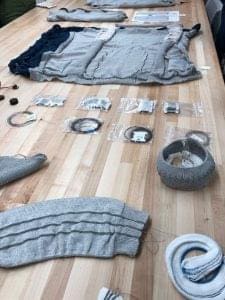fabrics that have electronics embedded in them to achieve certain functions – are of growing interest in the electronics manufacturing industry, and thus they are of growing interest to the IPC Government Relations team as well.
E-textiles and their requisite parts on display at the Drexel Center for Functional Fabrics
E-textiles are being developed and/or used for a variety of interesting applications, from sensing physiological changes in medical patients; to monitoring vital signs of military service members; to displaying warning lights on clothing that can call attention to first responders.
To learn more, last week I attended IPC E-Textiles 2019, a conference at the Drexel Center for Functional Fabrics (CFF) in Philadelphia, where designers, suppliers, engineers, and innovators met to exchange knowledge, network, and tour the CFF.
I learned that the IPC D-70 E-Textiles Committee has finalized an industry standard called IPC-8921, Requirements for Woven and Knitted Electronics Textiles Integrated with Conductive Fibers, Conductive Yarns and/or Wires, which is the first standard of its kind. I also heard from more than a dozen experts on the latest developments and challenges regarding materials, processing, testing, and applications.
As a member of IPC’s Government Relations team and as an environment, health and safety (EHS) professional, my objective was to bring the IPC spirit of innovation and collaboration to develop an advocacy strategy for e-textiles. As this field continues to evolve, IPC will be working to learn more from our members, educate policymakers, and advocate for policies that will support further progress. We’ll also be looking to collaborate with other associations and organizations touched by e-textiles – including in the military, medical, and automotive industries – to develop a comprehensive agenda backed by varied stakeholders with shared interests.
Advocating for innovation requires educating those outside of the innovation space. The IPC GR is well positioned to connect those on the inside with those on the outside to lessen the distance between the two.

